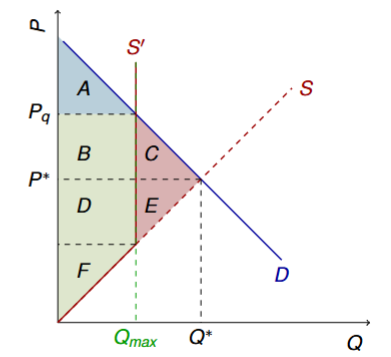Price Controls
1/39
Earn XP
Description and Tags
Microeconomics Lecture 9
Name | Mastery | Learn | Test | Matching | Spaced |
|---|
No study sessions yet.
40 Terms
Price ceiling
a maximum price set by the government, above which a good cannot be bought or sold
Non-binding price ceiling
when a price ceiling is set above the private market equilibrium and it is still legal to charge the equilibrium price
Binding price ceiling
when the price ceiling is set below the private market equilibrium price and the private market equilibrium price can no longer be legally charged
Binding price ceilings below the equilibrium cause persisting _____ _____
excess demand
When quantity demanded is higher than quantity supplied, which quantity is now the new equilibrium quantity?
quantity supplied (Qs)
To determine which consumers get to purchase the scarce good, we…
ration
Rationing
the act of allocating scarce goods/services/opportunities
Rationing mechanism
an institution that determines the rules for doing so
Under binding price ceilings below the equilibrium production is done by
producers with marginal costs below Pmax
Goods are rationed to consumers with…
the highest willingness to pay (WTP) (textbook assumption)
Consequences of the price ceiling
Fewer consumers and producers
Consumers who still buy get a better deal
Producers who still produce get a worse deal
Under a price ceiling, what happens to surplus?
producer surplus decreases
total surplus decreases
deadweight loss increases
consumer surplus is ambiguous (they lose some consumer surplus but gain a transfer from producer surplus that may or may not make up for the loss)
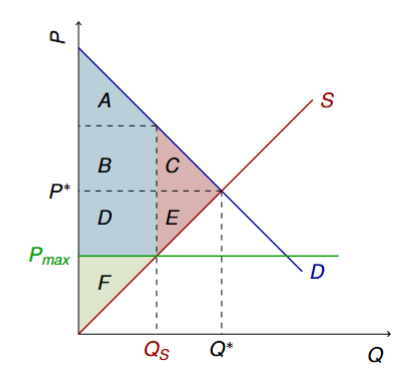
DWL arises due to a…
reduction in quantity supplied
What could justify DWL and PS to CS transfers in a price ceiling situation?
having a social welfare function (SWF) that puts more weight on CS than PS, and the CS gained being more than the CS lost
What happens to demand and Qd when a price ceiling below the equilibrium price results in wait times?
Demand falls, the demand curve shifts inward, and WTP falls as wait time rises
Quantity demanded (Qd) falls and excess demand shrinks because some consumers are not willing to wait (there is still some excess demand)
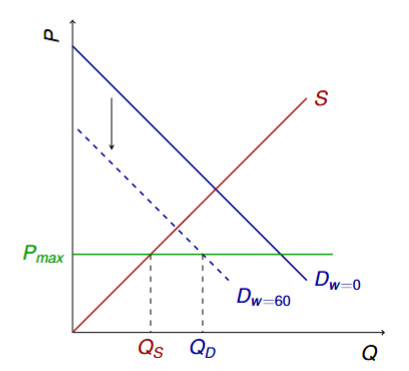
As wait times continue to increase, what happens to demand and Qd?
the demand curve continues to shift inward, quantity demanded by consumers willing to wait is equal to the quantity supplied (Qd = Qs), new equilibrium as a result
in this context, wait time adjusts to bring the market equilibrium, instead of the price adjusting like usual
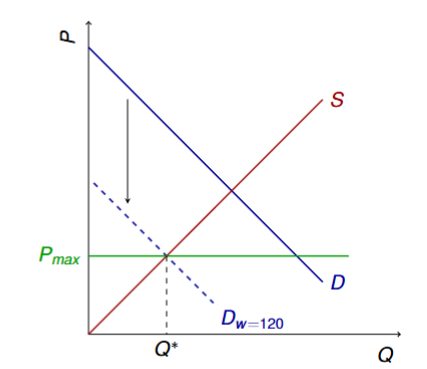
Who is affected by the wait times potentially caused by price ceilings?
producer surplus is unaffected
consumers lose a lot of surplus because they had to wait
Consumers pay two prices: Pmax + Pwait = Ptotal

When non-monetary costs are the rationing mechanism, what happens to surplus?
Consumer surplus ↓
Producer surplus ↓
Total surplus ↓ (DWL ↑)
No transfers from producers to consumers
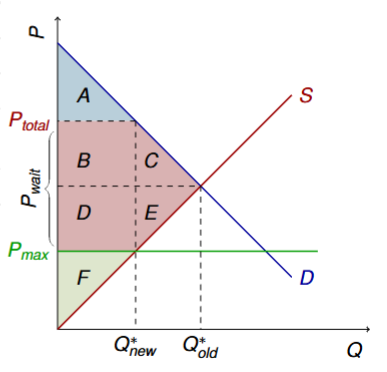
Alternative Rationing Mechanisms (other than wait time)
Lotteries
Explicit rationing
Bribery
Vouchers
True or false? Lotteries have DWL
True. DWL rises due to: Reduced production (similar to textbook case) and Re-allocation (households with high willingness to pay don’t get allocated units!)
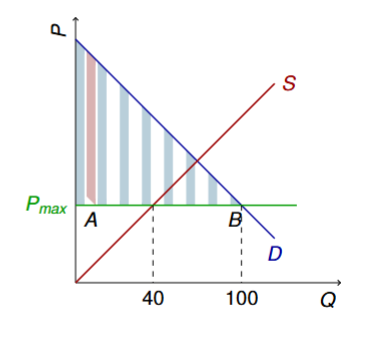
Examples of explicit Government/Producer Rationing
The government, or producer, decides who gets to consume at this price through
arbitrary rule
connections
status
Bribery
Consumers pay bribes to producers (or the government) in order to be the ones who get to consume at a low price
Why does bribery cause price ceilings to be ineffective
If consumers can bribe producers in cash, bribes replace prices, and we
return to the original no-price-control equilibrium (no efficiency loss bc ineffective price ceiling)
What happens to DWL in the case of non-transferable vouchers?
High WTP and low WTP households get an equal number of vouchers, leading to Deadweight loss due to misallocation
What happens to DWL in the case of transferable vouchers?
Low WTP households sell their vouchers to high WTP households, resulting in transfers from high WTP households to low WTP households, DWL looks similar to when the government imposes a tax
Price floor
a minimum price set by the government, below which a good cannot be bought or sold
Non-binding price floor
when a price floor is set below the private market equilibrium price and it is still legal to charge the PM equilibrium price
Binding price floor
when the price ceiling is set above the private market equilibrium price and the private market equilibrium price can no longer be legally charged
Binding price floors below the equilibrium cause persisting _____ _____
excess supply (Qs > Qd)
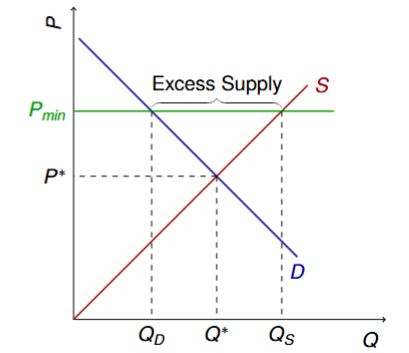
When quantity supplied is higher than quantity demanded, which quantity is now bought and sold?
quantity demanded (Qd)
What is the textbook assumption for which producers sell in a binding price floor situation?
Producers with the lowest cost produce
What is the textbook assumption for what happens to the binding price floor market in terms of surplus, price, and quantity?
Price ↑
Quantity ↓
Consumer surplus ↓
Deadweight loss ↑
Producer surplus might rise if producer surplus gained is worth more than lost

Why might DWL rise even higher under price floor conditions?
Reallocation to high-cost producers
Rising costs due to non-price competition e.g. advertising
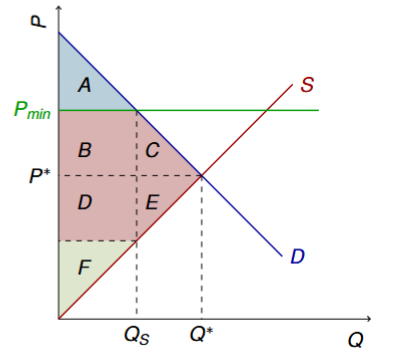
Reallocation to high-cost producers graph
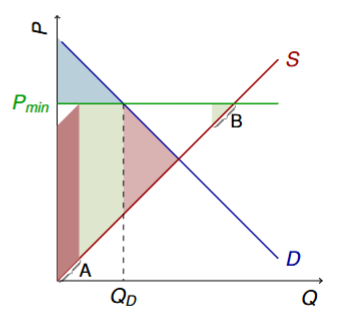
Rising costs due to non-price competition e.g. advertising graph

DWL formula
DWL = TS(Q∗) − TS(QM)
Q∗ (the efficient quantity) vs. QM (the actual quantity produced by the market)
Total surplus formula
CS + PS (need to know price)
Gross benefits (area under demand) - Total (marginal) costs (area under supply) (don’t need to know price)
The ____ elastic supply is, the greater the excess demand will be
more (there is also a more substantial decrease in Qs)
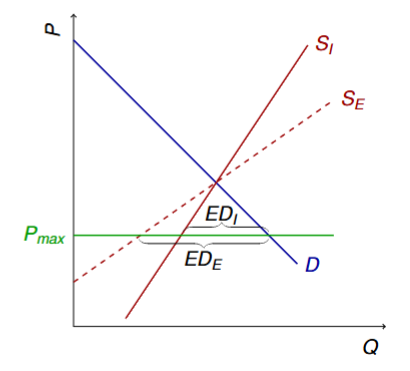
The ____ elastic demand is, the greater the excess demand will be
more (there is also a more substantial decrease in Qd)
Quota
A regulation that sets the quantity of a good or service provided
